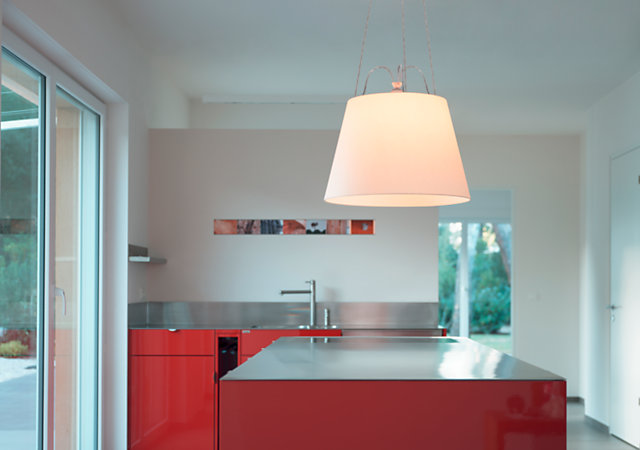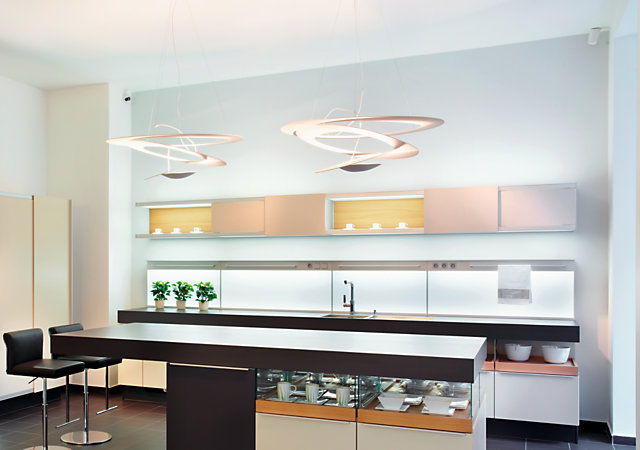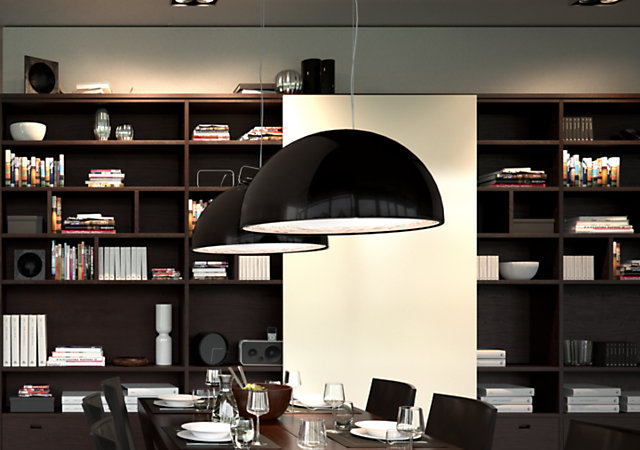Pendant lights are attached to the ceiling and are therefore space-saving. They usually illuminate even surfaces such as tables and counters. They are typically known as shaded luminaires with either downward light emission or both upward and downward light emission.
However, there are also some versions which only emit their light upwards just like uplighters, thereby providing ambient lighting. Luxurious
chandeliers that serve as an additional central eye-catcher within the dining room are also considered as pendant lights.

Upward and downward light emission
Pendant luminaires which emit their light upwards and downwards combine
ambient lighting with
zone lighting. The upward-directed light illuminates the ceiling and is scattered throughout the entire room. At the same time, the zone lighting emitted downwards illuminates a defined area.
Standard version: pendant luminaires are usually suspended from the ceiling by means of suspension cords with a shade or a reflector attached at the end.
The light11 recommendation
- The downward-directed zone lighting should not only selectively illuminate the dining table or the desks, it should rather provide even lighting for possibly the entire tabletop, without illuminating the area around the table. For extremely long dining tables, this is ensured by using elongated luminaires or multiple luminaires arranged in a row.
- The people sitting around dining table must not be blinded by the light, meaning that luminaires must not shine directly onto their faces. The recommended installation height for pendant luminaires that are installed above dining tables is therefore about 60 to 80cm above the tabletop.
- Particularly luminaires equipped with incandescent lamps and halogen lamps are ideally suited for dining tables as they emit even, warm and soft light. Furthermore, these lamps offer an excellent colour rendering so that the table shines in brilliant colours and they also makes sure that the food as well as the decoration are presented in the perfect light.
- In a dining room, it is recommended to use a light fixture with a dimmer as this allows for an individual adjustment of the lighting mood.
- If you do not wish to entirely illuminate the desk, a minimum area of 60cm x 60cm should still be illuminated as a main working area. A further important factor is that zone lighting for desks must shine downwards from the side so that the person working at the desk does not produce any annoying shadows. For right-handed people, the light should shine downwards onto the desk from the left, while for left-handed people it should be emitted downwards from the right.

Upward light emission
Pendant luminaires which emit their light upwards provide for ambient lighting by illuminating the ceiling; from here, the light is then dispersed throughout the entire room.
Typical areas of use: this type of lamp is used to supply ambient lighting for general orientation purposes in living rooms, dining rooms, bedrooms, studies, kitchens and hallways.
Standard version: pendant luminaires with upward light emission are known as uplighters. They are usually suspended from the ceiling by means of suspension cords with a shade or reflector attached at the end.
The light11 recommendation
- Pendant luminaires with upward light emission should emit their light broadly and evenly to illuminate a large area of the ceiling. If the ceiling is only illuminated at a specific point, your eyes feel blinded by the bright spot of light.
- Pendant lights with a flexibly adjustable shade or reflector are recommended for sloped walls and ceilings.
- It is recommended to use a light fixture with a dimmer as this allows for an individual adjustment of the lighting mood.

Downward light emission
Pendant lamps which emit their light downwards supply zone lighting directed downwards which illuminates a defined area.
Typical areas of use: this type of luminaire is usually used in dining rooms to supply
zone lighting for dining table.
Standard version: pendant luminaires are usually suspended from the ceiling by means of suspension cords with a shade or reflector attached at the end.
The light11 recommendation
- The downward-directed zone lighting should not only selectively illuminate the dining table, it should rather possibly provide comprehensive and even lighting without illuminating the area around the table. For extremely long dining tables, this is ensured by using elongated luminaires or multiple luminaires arranged in a row.
- The people sitting around the dining table must not be blinded by the light, meaning that luminaires must not shine directly onto their faces. The recommended installation height for pendant luminaires installed above the dining table is therefore about 60 to 80cm above the tabletop.
- Particularly luminaires equipped with incandescent lamps and halogen lamps are ideally suited for dining tables as they emit even, warm and soft light. Furthermore, these lamps offer an excellent colour rendering so that the table shines in brilliant colours and they also make sure that the food as well as the decoration are presented in the perfect light.
- In a dining room, it is recommended to use a light fixture with a dimmer as this allows for an individual adjustment of the lighting mood.



